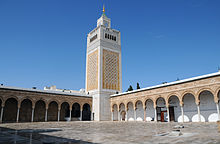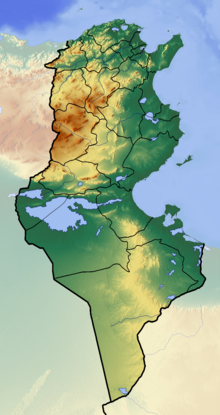Our website is made possible by displaying online advertisements to our visitors.
Please consider supporting us by disabling your ad blocker.
Al-Zaytuna Mosque
| Al-Zaytuna Mosque | |
|---|---|
جامع الزيتونة | |
 | |
| Religion | |
| Affiliation | Islam |
| Branch/tradition | Sunni |
| Location | |
| Location | Tunis, Tunisia |
| Geographic coordinates | 36°47′50″N 10°10′16″E / 36.7972°N 10.1711°E |
| Architecture | |
| Architect(s) | Fathallah (Fath al-Banna') |
| Type | Mosque |
| Style | Moorish (Aghlabid and other periods) |
| Date established | 698 CE |
| Completed | 864 CE (with later additions) |
| Specifications | |
| Minaret(s) | 1 |
| Minaret height | 43 meters (141 ft 1 in) |
Al-Zaytuna Mosque, also known as Ez-Zitouna Mosque, and El-Zituna Mosque (Arabic: جامع الزيتونة, literally meaning the Mosque of Olive), is a major mosque at the center of the Medina of Tunis in Tunis, Tunisia. The mosque is the oldest in the city and covers an area of 5,000 square metres (1.2 acres) with nine entrances.[1] It was founded at the end of the 7th century or in the early 8th century, but its current architectural form dates from a reconstruction in the 9th century, including many antique columns reused from Carthage, and from later additions and restorations over the centuries.[2][3]
The mosque developed into a place of higher education, today the University of Ez-Zitouna, which became the most important educational institution in Tunisia from around the 13th century onward.[2] Ibn 'Arafa, a major Maliki scholar, al-Maziri, the great traditionalist and jurist, and Aboul-Qacem Echebbi, a famous Tunisian poet, all taught there, among others.[1][4][5]
- ^ a b Ben Achour, M.A. (1991). Masjid al-Zaytūna: al-rijalu wa’l ma’lem [The Zaytuna Mosque: the men and the monument] (in Arabic). Tunis: Cérès Production.
- ^ a b Cite error: The named reference
:052was invoked but never defined (see the help page). - ^ Cite error: The named reference
:0was invoked but never defined (see the help page). - ^ Cite error: The named reference
zay-wswas invoked but never defined (see the help page). - ^ "Al-Zaytuna Theological and Scientific Influence on the Islamic World". Al-Zaytuna Mosque. Archived from the original on 2010-05-12. Retrieved 2009-02-06.
Previous Page Next Page



